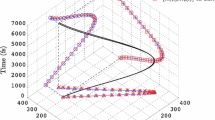Abstract
It is generally argued that if the wave-function in the de Broglie–Bohm theory is a physical field, it must be a field in configuration space. Nevertheless, it is possible to interpret the wave-function as a multi-field in three-dimensional space. This approach hasn’t received the attention yet it really deserves. The aim of this paper is threefold: first, we show that the wave-function is naturally and straightforwardly construed as a multi-field; second, we show why this interpretation is superior to other interpretations discussed in the literature; third, we clarify common misconceptions.


Similar content being viewed by others
Notes
However, we will not enter here in the metaphysical issue concerning the nature of fields. As the notion of a classical field can be framed in different metaphysical frameworks (for example, Humean view, dispositional view, etc.), the same procedure is in principle applicable to the multi-field.
Chen (2017b) challenges the view of defining the wave-function in mathematical terms; he instead proposes a nominalistic approach.
The conditional wave-function ψt(x) of a particle is defined by the universal wave-function Ψ, once the positions of all the other particles in the universe Y (t) are fixed: ψt(x) := Ψ(x,Y (t)).
More explicitly, there are two types of locality: ontological locality and dynamical locality. The former coincides with separability and is about local beables, while the latter is about the behavior of physical objects, for instance, Bell’s notion of local causality or Einstein’s locality.
References
Albert, D.Z. (1994). Quantum mechanics and experience. Cambridge: Harvard University Press.
Albert, D.Z. (1996). Elementary quantum metaphysics. In Cushing, J.T., Fine, A., & Goldstein, S. (Eds.) Bohmian mechanics and quantum theory: an appraisal (pp. 277–284). Netherlands: Springer.
Albert, D.Z. (2015). After physics. Cambridge: Harvard University Press.
Allori, V. (2017). A new argument for the nomological interpretation of the wave function: The Galilean group and the classical limit of nonrelativistic quantum mechanics. International Studies in the Philosophy of Science, forthcoming.
Bell, J.S. (1987). Speakable and unspeakable in quantum mechanics. Cambridge: Cambridge University Press.
Belot, G. (2012). Quantum states for primitive ontologists. European Journal for Philosophy of Science, 2(1), 67–83.
Bhogal, H., & Perry, Z. (2017). What the Humean should say about entanglement. Noûs, 51(1), 74–94.
Bohm, D., & Hiley, B.J. (1993). The undivided universe: an ontological interpretation of quantum theory. London: Routledge.
Callender, C. (2015). One world, one beable. Synthese, 192(10), 3153–3177.
Chen, E.K. (2017a). Our fundamental physical space: an essay on the metaphysics of the wave function. The Journal of Philosophy, 114(7), 333–365.
Chen, E.K. (2017b). An intrinsic theory of quantum mechanics: progress in Field’s nominalistic program, part i. Preprint. http://philsci-archive.pitt.edu/13083/.
Darby, G. (2012). Relational holism and Humean supervenience. The British Journal for the Philosophy of Science, 63(4), 773–788.
Dürr, D., Goldstein, S., & Zanghì, N. (2013). Quantum physics without quantum philosophy. Heidelberg: Springer.
Emery, N. (2017). Against radical quantum ontologies. Philosophy and Phenomenological Research. Advance access. https://doi.org/10.1111/phpr.12444.
Esfeld, M., Lazarovici, D., Hubert, M., & Dürr, D. (2014). The ontology of Bohmian mechanics. The British Journal for the Philosophy of Science, 65(4), 773–796.
Forrest, P. (1988). Quantum metaphysics. Oxford: Basil Blackwell.
Goldstein, S., & Zanghì, N. (2013). Reality and the role of the wave function in quantum theory. In Ney, A., & Albert, D.Z. (Eds.) The wave function: essays on the metaphysics of quantum mechanics, chapter 4 (pp. 91–109). New York: Oxford University Press.
Holland, P.R. (1993). The quantum theory of motion. Cambridge: Cambridge University Press.
Loewer, B. (1996). Humean supervenience. Philosophical Topics, 24(1), 101–127.
Maudlin, T. (2013). The nature of the quantum state. In Ney, A., & Albert, D.Z. (Eds.) The wave function: essays on the metaphysics of quantum mechanics, chapter 6, (pp. 126–153). New York: Oxford University Press.
Maudlin, T. (2015). The universal and the local in quantum theory. Topoi, 34 (2), 349–58.
Miller, E. (2014). Quantum entanglement, Bohmian mechanics, and Humean supervenience. Australasian Journal of Philosophy, 92(3), 567–83.
Monton, B. (2013). Against 3N-dimensional space. In Ney, A., & Albert, D.Z. (Eds.) The wave function: essays on the metaphysics of quantum mechanics, chapter 7 (pp. 154–167). New York: Oxford University Press.
Norsen, T. (2010). The theory of (exclusively) local beables. Foundations of Physics, 40(12), 1858–1884.
Norsen, T., Marian, D., & Oriols, X. (2015). Can the wave function in configuration space be replaced by single-particle wave functions in physical space? Synthese, 192(10), 3125–3151.
Schaffer, J. (2009). On what grounds what. In Chalmers, D.J., Manley, D., & Wasserman, R. (Eds.) Metametaphysics: new essays on the foundations of ontology, chapter 12 (pp. 347–383). New York: Oxford University Press.
Sellars, W. (1963). Empiricism and the philosophy of mind. In Science perception and reality (pp. 127–196). Atascadero: Ridgeview Company.
Suárez, M. (2015). Bohmian dispositions. Synthese, 192(10), 3203–28.
Valentini, A. (2010). De Broglie–Bohm pilot-wave theory: many worlds in denial? In Saunders, S., Barrett, J., Kent, A., & Wallace, D. (Eds.) Many worlds? Everett, quantum theory, and reality, chapter 16 (pp. 476–509). New York: Oxford University Press.
Wald, R.M. (1984). General relativity. Chicago: The University of Chicago Press.
Acknowledgements
We wish to thank David Albert, Guido Bacciagaluppi, Michael Esfeld, Dustin Lazarovici, Tim Maudlin, Matteo Morganti, Travis Norsen, Andrea Oldofredi, Charles Sebens, and Tiziano Ferrando for many helpful comments on previous drafts of this paper. We also thank the audience of the 3rd Annual Conference of the Society for the Metaphysics of Science (SMS) and especially Lucas Dunlap for commenting on our paper at this event. We also thank two anonymous referees for their very detailed reviews. Davide Romano’s research was funded by the Swiss National Science Foundation (grant no. 105212_149650).
Author information
Authors and Affiliations
Corresponding author
Rights and permissions
About this article
Cite this article
Hubert, M., Romano, D. The wave-function as a multi-field. Euro Jnl Phil Sci 8, 521–537 (2018). https://doi.org/10.1007/s13194-017-0198-9
Received:
Accepted:
Published:
Issue Date:
DOI: https://doi.org/10.1007/s13194-017-0198-9



